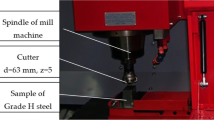Abstract
This paper presents a new approach to determine the optimal cutting parameters leading to minimum surface roughness in face milling of X20Cr13 stainless steel by coupling artificial neural network (ANN) and harmony search algorithm (HS). In this regard, advantages of statistical experimental design technique, experimental measurements, analysis of variance, artificial neural network and harmony search algorithm were exploited in an integrated manner. To this end, numerous experiments on X20Cr13 stainless steel were conducted to obtain surface roughness values. A predictive model for surface roughness was created using a feed forward neural network exploiting experimental data. The optimization problem was solved by harmony search algorithm. Additional experiments were performed to validate optimum surface roughness value predicted by HS algorithm. The obtained results show that the harmony search algorithm coupled with feed forward neural network is an efficient and accurate method in approaching the global minimum of surface roughness in face milling.
Similar content being viewed by others
References
Huang B, Chen JC (2003) An in process neural network based surface roughness prediction (INN-SRP) system using a dynamometer in end milling operations. Int J Adv Manuf Technol 21:339–347
Kohli A, Dixit US (2005) A neural network based methodology for the prediction of surface roughness in a turning process. Int J Adv Manuf Technol 25:118–129
Dagnal MA (1986) Exploring surface texture. Rank Taylor Hobson, Leicester
Box GEP, Draper NR (1987) Empirical model-building and response surface. Wiley, New York
Luong LHS, Spedding TA (1995) Neural-network system for predicting machining behavior. J Mater Process Technol 52:585–591
Petri KL, Billo RE, Bidanda B (1998) A neural network process model for abrasive flow machining operations. J Manuf Sci 17(1):52–64
Zang HC, Huang SH (1995) Application of neural network in manufacturing-a state of art survey. Int J Prod Res 33(3):705–728
Kalpakjian S, Schmid SR (2001) Manufacturing Engineering and Technology. Prentice Hall, New Jersey
Lou S (1997) Development of four in process surface recognition systems to predict surface roughness in end milling. University of Iowa State, Dissertation
Godfrey C, Onwubolu (2006) Performance based optimization of multi pass face milling operations using Tribes. Int J Mach Tool Manuf 46:717–727
Dong YJ, Young-Gu C, Hong-Gil K, Hsiao A (1996) Study of the correlation between surface roughness and cutting vibrations to develop an on-line roughness measuring technique in hard turning. Int J Mach Tools Manuf 36(4):453–464
SECO Milling 1 (2007) Catalogue & Technical Guide. SECO Tools AB, 737 82 Fagersta, Sweden
Keppel G, Zedeck S (1989) Data analysis for research designs: analysis of variance and multiple research/correlation approaches. Freeman, New York
Rosse P (1996) Taguchi techniques for quality engineering, loss funktion, orthogonal experiments, parameter and tolerance design. McGraw-Hill, Toronto
Sanjay C, Jyothi C (2006) A study of surface roughness in drilling using mathematical analysis and neural networks. Int J Adv Manuf Technol 29:846–852
Tansela IN, Ozcelikb B, Baoa WY, Chena P, Rincona D, Yanga SY, Yenilmezc A (2006) Selection of optimal cutting conditions by using GONNS. Int J mach Tool Manuf 46:26–35
Chen Jacob C, Chen Joseph C (2005) An artificial neural networks based in process tool wear prediction system in milling operations. Int J Adv Manuf Technol 25:427–434
Seok LK, Geem ZW (2005) A new meta-heuristic algorithm for continuous engineering optimization: harmony search theory and practice. Comput Methods Appl Mech Engrg 194:3902–3933
Fogel LJ, Owens AJ, Walsh MJ (1966) Artificial Intelligence through Simulated Evolution. Wiley, Chichester
Jong KD (1975) Analysis of the behavior of a class of genetic adaptive systems. Dissertation, University of Michigan
Koza JR (1990) Genetic programming: a paradigm for genetically breeding populations of computer programs to solve problems. Rep No STAN-CS-90-1314, Stanford University, CA
Holland JH (1975) Adaptation in natural and artificial systems. Dissertation University of Michigan Press
Goldberg DE (1989) Genetic algorithms in search, optimization and machine learning, Addison. Wesley, Boston
Glover F (1977) Heuristic for integer programming using surrogate constraints. Decision Sci 8(1):156–166
Kirkpatrick S, Gelatt C, Vecchi M (1983) Optimization by simulated annealing. Science 220(4598):671–680
Geem ZW, Kim JH, Loganathan GV (2001) a new heuristic optimization algorithm: harmony search. simul 76(2):60–68
Kim JH, Geem ZW, Kim ES (2001) Parameter estimation of the nonlinear Muskingum model using harmony search. J Am Water Resour Assoc 37(5):1131–1138
SuperNEC (2004) Success of the GA optimiser. In: Genetic Algorithm Optimiser User Reference Manual. SuperNEC Group. Available via DIALOG: http://www.supernec.com/manuals/sngaum.htm#_Toc21938615. Accessed July 2004
Author information
Authors and Affiliations
Corresponding author
Rights and permissions
About this article
Cite this article
Razfar, M.R., Farshbaf Zinati, R. & Haghshenas, M. Optimum surface roughness prediction in face milling by using neural network and harmony search algorithm. Int J Adv Manuf Technol 52, 487–495 (2011). https://doi.org/10.1007/s00170-010-2757-5
Received:
Accepted:
Published:
Issue Date:
DOI: https://doi.org/10.1007/s00170-010-2757-5




